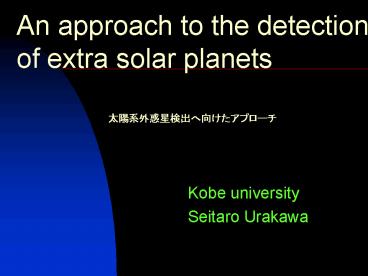Kobe university PowerPoint PPT Presentation
1 / 16
Title: Kobe university
1
?????????????????
An approach to the detection of extra solar
planets
- Kobe university
- Seitaro Urakawa
2
MENU
Aperitif Purpose of the detection of
extra solar (???) planets Hors
doeuvrePrevious work (??) Main dish
The relationship of rotational velocity (??)
between hosting planet star and not
hosting
planet star Sub dish How to detect
extra solar planets? (??)
(particularly transit method) Dessert
Future work (????)
3
Purpose of the detection of extra solar planets
- The first extra solar planet was discovered by
Mayor in 1995. - It is a quite different figure from our solar
system. ?Necessity of a general planet system
formation theory. - It is required more observational data of extra
solar planets to develop the theory.
For efficient detection,we must know what kind of
stars tend to hold planets.
4
Previous work
- Now, 117 extra solar planets have been detected.
- Based on such increasing data it is possible to
discuss statistically. - Metal-rich stars have a tendency to hold planets.
- (Santos et al.2001,2003)
- (Migration model or hosting planet stars are
formed from metal-rich molecular clouds.)
Other stellar properties?
5
The relationship of rotational velocity between
hosting and not hosting planet stars
- I concentrate on the rotational velocity of stars.
Reason
If the angular momentum of a protoplanetary disk
is conserved during planetary system formation,
we can describe it as 2 groups
?Hosting planet starPlanets and small
objectsStellar wind Rotational velocity of the
star. ?Not hosting planet starStellar wind
Rotational velocity of the star
6
- Most of the angular momentum of a solar system
belong to planets and small objects like KBOs,
Oort cloud objects.(Weissman.1990)
Is the rotational velocity of hosting planet
star slower than that of not hosting planet?
7
DATA(I used published data.)
Comparison of rotational velocity
Sample A
Sample B
- Hosting planet stars
- Not hosting planet stars
- Catalog of Projected Rotational Velocities
(ftp//cdsarc.ustrasbg.fr/pub/cats/3/226/) - CaliforniaCarnegie Planet Search
- (http//exoplanet.org/)
- Catalog of Projected Rotational
- Velocities (ftp//cdsarc.ustrasbg.fr/pub/cats/3/22
6/)
52 stars
8
Data selection
Sample B
- Not hosting planet stars
- Catalog of Projected Rotational Velocities
(ftp//cdsarc.ustrasbg.fr/pub/cats/3/226/)
11700stars
Condition1G,Ktype dwarf stars. Condition2Single
stars. Condition3Not young stars. (Except T-tau
type, cluster stars)
705 stars
9
Histogram
Sample A
Sample B
It is needed to test whether the above two
samples are originated from the same parent
population or not.
10
Test method?Kolmogorov-Smirnov test?
- It is a nonparametric method which verifies if
two distributions are different. - HypothesisSample A and sample B originate from
the same population.(In other words sample A and
B possess the same rotational velocity
distribution.) - Comparing the cumulative functions of sample A
and B, if the difference is very large the
hypothesis can be rejected.
Sample A and B have different rotational velocity
distributions.
11
Result
Cumulative function of sample A
Cumulative function of sample B
NaNumber of sample A
NbNumber of sample B
NNa Nb/ (Na Nb)
?(vN0.120.11/vN)D
ProbabilityPK(?)2?(-1)j-1exp(-2j2?2)?2.810-12
12
Summary
- The probability that sample A and B are from the
same population is 2.810-12. - Sample A and B originate from different
populations. - Rotational velocity of hosting planet star is
slower than that of not hosting planet. - There is higher probability that extra solar
planets are detected around slow rotational
velocity stars. (under 2km/s)
13
How to detect extra solar planets?
- Doppler shift method.
- Direct imaging.(Corona graph)
- Transit method.
- Microlensing method, etc
14
Transit method
This method detects the flux change of a star
during planet transit. ?F(Rplanet2/Rstar2)
?1
15
Probability of detection
Pt2R/2paR/pa?1-2
and
Effect of inclination
and
Not every star holds planets.
Detection probability Pfinal?0.003
16
Future work
If we observe more than 3-40000 stars, a few
extra solar planet can be detected.
Subaru Telescope Sprime-Cam
Field of view2734
This instrument consists of 10 CCDs.
Only one CCD image
2002.9/28.Naoj.Mr.yamada
????? Please wait spetacular discoveries!

